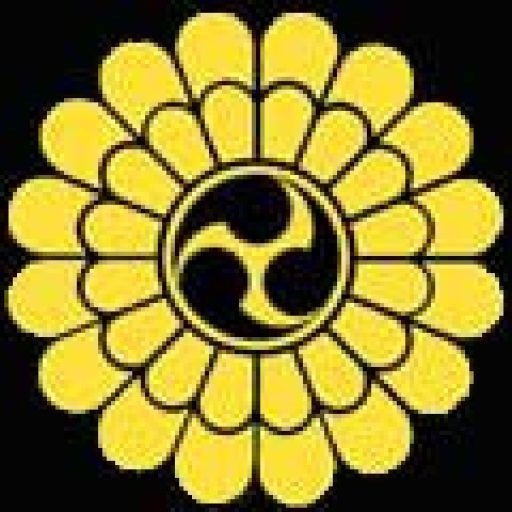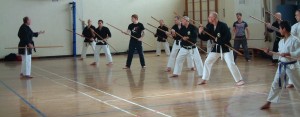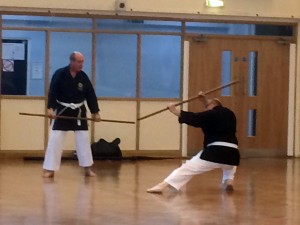Below is the 2nd article of seven which was written by Bateman Sensei and published in the magazine Martial Arts Illustrated.
Introduction
I have had many discussions with various martial artists why we need to study weapons, especially the old traditional weapons of Kobudo. My answer is simply this- These weapons have come from every day implements back when weapons were banned in Okinawa. The practitioners studied how each one can be used to form a defensive style against their oppressors. By doing this it provided the practitioner of kobudo the co-ordination, speed, strength and endurance in utilising the respective weapon. The study also provides the knowledge of distance, trajectory, timing, control and flexibility of the weapon being used. This gives a great advantage over the empty hand practitioner who does not study the art of weapons. Each one can be translated into a modern day tool, such as the Bo techniques can be used with walking sticks, branches or even the umbrella. The Nunchaku, or Surichin, techniques can be used with belts or dog leads (including the extendable types). So then why not practice with the modern day tools. The answer is simply that I’m a traditional martial artist and the techniques/syllabus for these tools have been set in stone and used in defensive situations by our masters of yesteryear.
Now we have decided to study these weapons it would therefore be nice to know their history. How their individual art forms have come about, one has to look back in time into the history of the Okinawan people. This I have already provided in a past article, see March 2014 edition of MAI. I shall start this series of Matayoshi Kobudo weapons with Matayoshi Kobudo Kodokan International’s (MKKI) principal weapon – the Bo.
History of the Bo
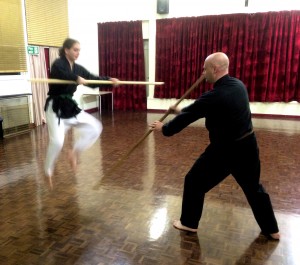
From the beginning of time man has used a Bo type weapon. In fact the earliest weapon would have been a club made from a branch of a tree. There has also been archaeological findings of Bo made from stone; it is known as Ishibo. One can only imagine the problems of this type of weapon, for example hard to produce and braking up in a conflict. In the UK we all know about Robin Hood’s meeting with Little John where Robin wanted to cross the river and had to fight Little John with a Quarter Staff. It is said that the name of Quarter Staff is alleged to arise from its manufacture from a tree that was split into quarters. The Quarter Staff was used extensively in self defence during the Middle Ages in Europe. It was an excellent defensive weapon against the sword due to its range and varied techniques.
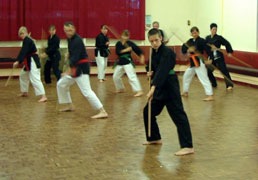 We can see this too in the history from Okinawa. There the people had to develop an effective means to defend themselves from their oppressive overlords. Although there is no hard written evidence of the development of Bojutsu, or indeed for Kobudo per se, it is thought to have arisen because of the weapons ban. This seems to stem from the 2nd Sho Dynasty in 1477 when the Emperor Sho Shin, the third Emperor of the Sho Dynasty, decided to ban weapons to enforce his principles and to prevent his overthrow. This was the period of the Golden Age in Okinawa when trade became affluent amongst the people and peace lasted for many years. However, due to political conflicts from Japan, Okinawa was invaded in March 1609 by the Satsuma Clan. They again enforced a weapons ban and demanded taxes and goods for Tokugawa in Japan. They enforced high ranking officials to pledge their allegiance. Hence, Okinawa was caught up in a political struggle between Japan and China. Unlike Okinawa, Japan did not have a good relationship with China, but they wanted the trade that Okinawa had. So through the Satsuma Clan, Japan imposed its control. It seems that the only way the Okinawans could defend themselves was by evolving their art of kobudo; using simple tools. It is thought that the Bo techniques came from China through Sapposhi (Chinese envoys) visiting Okinawa. Also the Okinawans went to Southern China, or Shanghai to learn Bo-jutsu. Matayoshi Shinko Sensei was known to travel to China for his training in the martial arts.
We can see this too in the history from Okinawa. There the people had to develop an effective means to defend themselves from their oppressive overlords. Although there is no hard written evidence of the development of Bojutsu, or indeed for Kobudo per se, it is thought to have arisen because of the weapons ban. This seems to stem from the 2nd Sho Dynasty in 1477 when the Emperor Sho Shin, the third Emperor of the Sho Dynasty, decided to ban weapons to enforce his principles and to prevent his overthrow. This was the period of the Golden Age in Okinawa when trade became affluent amongst the people and peace lasted for many years. However, due to political conflicts from Japan, Okinawa was invaded in March 1609 by the Satsuma Clan. They again enforced a weapons ban and demanded taxes and goods for Tokugawa in Japan. They enforced high ranking officials to pledge their allegiance. Hence, Okinawa was caught up in a political struggle between Japan and China. Unlike Okinawa, Japan did not have a good relationship with China, but they wanted the trade that Okinawa had. So through the Satsuma Clan, Japan imposed its control. It seems that the only way the Okinawans could defend themselves was by evolving their art of kobudo; using simple tools. It is thought that the Bo techniques came from China through Sapposhi (Chinese envoys) visiting Okinawa. Also the Okinawans went to Southern China, or Shanghai to learn Bo-jutsu. Matayoshi Shinko Sensei was known to travel to China for his training in the martial arts.
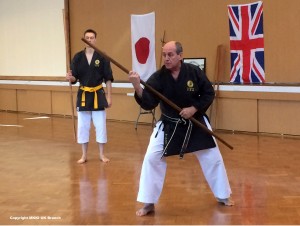 So it seems that the Bo can be traced back to China. In Chinese history it is seen to be used by the Shaolin Monks who were founded by Bohidarma during the 5th/6th Century. One famous image is of him carrying one sandal over his shoulder on the end of a Bo. So we can see that it was used as a walking stick, or for carrying. The staff known as Tenbin was used for carrying baskets and buckets which contained food, water or milk. It was balanced across the shoulders with the baskets on either end. We see this proof in the opening move of the kata Chikin No Kun. So this Bo was an effective tool that could be used as a weapon after disengaging its baskets.
So it seems that the Bo can be traced back to China. In Chinese history it is seen to be used by the Shaolin Monks who were founded by Bohidarma during the 5th/6th Century. One famous image is of him carrying one sandal over his shoulder on the end of a Bo. So we can see that it was used as a walking stick, or for carrying. The staff known as Tenbin was used for carrying baskets and buckets which contained food, water or milk. It was balanced across the shoulders with the baskets on either end. We see this proof in the opening move of the kata Chikin No Kun. So this Bo was an effective tool that could be used as a weapon after disengaging its baskets.
Okinawan fishermen used the staff to navigate their boats around mangroves and roots where oars were difficult to be used. These were called Kushaku Bo and were 9 foot in length. Another unusual use of the Bo is of stories that have been told were the Bo was used to scale castle walls by inserting the Bo between the stones and using them as steps.
Whether it was used as a walking stick, a pole for carrying goods, to navigate the mangroves, or to scale walls of castles, it is the most commonly used weapon in Okinawan Kobudo systems. It has the refinement, the power and provides the extension required for defence against most weapons.
Types of Bo
The name Bo is from the Japanese language, however it is also known as Kun (Okinawa), Kon (China) and Dong (Korea). The sizes vary providing different types of Bo, such as:
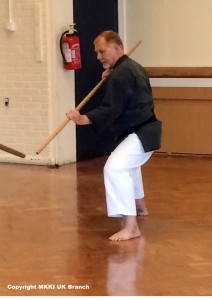
- Han Bo – 3 foot (Han means half, so Han Bo is half the size of a Bo),
- Jo – 4 foot,
- Go Shaku Bo – 5 foot,
- Roku Shaku Bo – 6 foot (Roku meaning six, and the Shaku is a measurement of just under a foot),
- Roku Shaku Han Bo – 6 foot 6 inches,
- Ku Shaku Bo – 9 foot
I would just like to point out that although I have listed the Jo above; it has only been recently introduced by some Okinawan Sensei into their systems. It is not an Okinawan weapon and even less so from the Matayoshi Kobudo system. The history of this weapon firmly lays within in the Japanese weapon systems.
They are also known to be made from different types of materials. I have already said that one has been reportedly made from stone. Some have been known to be inlaid with iron to provide extra strength, but lack the flexibility required during impact. Others have been made from Bamboo, but the most common type is those made from the hard woods, such as red oak.
The Bo can vary in shape as well, such as square (Kaku Bo), hexagon (Rokkaku Bo) or Octagon (Hakkaku Bo). However, the most common are the circular Bo (Maru Bo) and are known as Roku Shaku Bo. These are either straight or tapered from the centre (Chukon-bu) around 1½” thick to the ends (Kontei) of ¾” thick. This tapering maintains the fulcrum at the centre of the Bo, providing good balance and ease of handling. It also facilitates a powerful whipping action during striking and blocking. However the downside of the tapered Bo against the straight Bo is that it is not as strong at the ends and can be subjected to breaking during blocks or striking. This straight Bo, known as the Kon originating from China, will not be balanced at the centre. This is not important as the Chinese systems involve handling the Kon from one end or the other. This Kon can also measure eight feet to nine feet in length, and has a very flexible whipping ability, as seen by the techniques used by the Shaolin Monks.
Fundamentals of Matayoshi Bojutsu
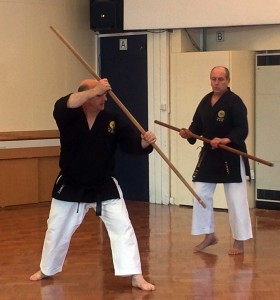 The Bo in the Matayoshi system is a long range weapon and is used for striking, blocking, sweeping and entrapment. Within this system techniques are seen where the Bo is used to flick sand, and even in a cutting action. It is generally held in thirds with the front hand palm up and the back hand palm down. This enables fast rotation of the weapon generating power during the strike. In addition to this both hands pull and push, depending on the strike or block. Adding to this rotational power, there is a penetrating linier power, using the weight from the body, the hips, and penetration of the Bo by turning the hand upon impact. All this comes together in what is known as Karada To Bugu Issho – Weapon and Body are One. This is another reason why I think martial artists should study weapons along with their empty hand arts, as it teaches these dynamics especially if they need to use this weapon to defend their selves.
The Bo in the Matayoshi system is a long range weapon and is used for striking, blocking, sweeping and entrapment. Within this system techniques are seen where the Bo is used to flick sand, and even in a cutting action. It is generally held in thirds with the front hand palm up and the back hand palm down. This enables fast rotation of the weapon generating power during the strike. In addition to this both hands pull and push, depending on the strike or block. Adding to this rotational power, there is a penetrating linier power, using the weight from the body, the hips, and penetration of the Bo by turning the hand upon impact. All this comes together in what is known as Karada To Bugu Issho – Weapon and Body are One. This is another reason why I think martial artists should study weapons along with their empty hand arts, as it teaches these dynamics especially if they need to use this weapon to defend their selves.
The Matayoshi Kobudo Kodokan system teaches this in various Bo No Hojo Undo sets and in the Bo Kata. There are 5 Kata that are extensively studied, starting with Shushi No Kun, and Choun No Kun. The style is steeped in partner work, which is important to learn the required distance and timing needed to defend against the various weapons. To the untrained eye the techniques look as if it uses power on power in the various blocking actions. But this is far from the truth as the art teaches how to deflect away in incoming power from the opponent’s weapon. These subtleties is what I think makes Matayoshi Kobudo Kodokan different from some of the other so called Matayoshi Styles.
